In today’s guest post, Bruce Tulloch, CEO and Managing Director of BitScope Designs, discusses the uses of cluster computing with the Raspberry Pi, and the recent pilot of the Los Alamos National Laboratory 3000-Pi cluster built with the BitScope Blade.
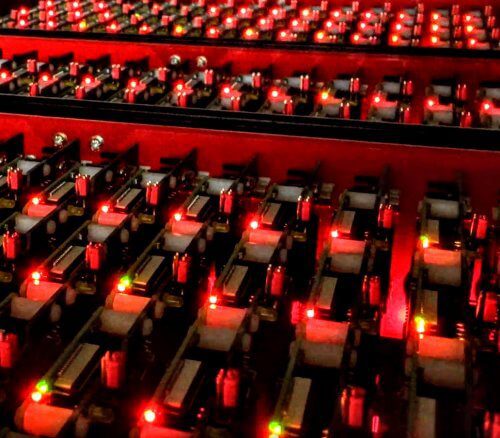
High-performance computing and Raspberry Pi are not normally uttered in the same breath, but Los Alamos National Laboratory is building a Raspberry Pi cluster with 3000 cores as a pilot before scaling up to 40 000 cores or more next year.
That’s amazing, but why?
I was asked this question more than any other at The International Conference for High-Performance Computing, Networking, Storage and Analysis in Denver last week, where one of the Los Alamos Raspberry Pi Cluster Modules was on display at the University of New Mexico’s Center for Advanced Research Computing booth.
The short answer to this question is: the Raspberry Pi cluster enables Los Alamos National Laboratory (LANL) to conduct exascale computing R&D.
The Pi cluster breadboard
Exascale refers to computing systems at least 50 times faster than the most powerful supercomputers in use today. The problem faced by LANL and similar labs building these things is one of scale. To get the required performance, you need a lot of nodes, and to make it work, you need a lot of R&D.
However, there’s a catch-22: how do you write the operating systems, networks stacks, launch and boot systems for such large computers without having one on which to test it all? Use an existing supercomputer? No — the existing large clusters are fully booked 24/7 doing science, they cost millions of dollars per year to run, and they may not have the architecture you need for your next-generation machine anyway. Older machines retired from science may be available, but at this scale they cost far too much to use and are usually very hard to maintain.
The Los Alamos solution? Build a “model supercomputer” with Raspberry Pi!
Think of it as a “cluster development breadboard”.
The idea is to design, develop, debug, and test new network architectures and systems software on the “breadboard”, but at a scale equivalent to the production machines you’re currently building. Raspberry Pi may be a small computer, but it can run most of the system software stacks that production machines use, and the ratios of its CPU speed, local memory, and network bandwidth scale proportionately to the big machines, much like an architect’s model does when building a new house. To learn more about the project, see the news conference and this interview with insideHPC at SC17.
Traditional Raspberry Pi clusters
Like most people, we love a good cluster! People have been building them with Raspberry Pi since the beginning, because it’s inexpensive, educational, and fun. They’ve been built with the original Pi, Pi 2, Pi 3, and even the Pi Zero, but none of these clusters have proven to be particularly practical.
That’s not stopped them being useful though! I saw quite a few Raspberry Pi clusters at the conference last week.
One tiny one that caught my eye was from the people at openio.io, who used a small Raspberry Pi Zero W cluster to demonstrate their scalable software-defined object storage platform, which on big machines is used to manage petabytes of data, but which is so lightweight that it runs just fine on this:
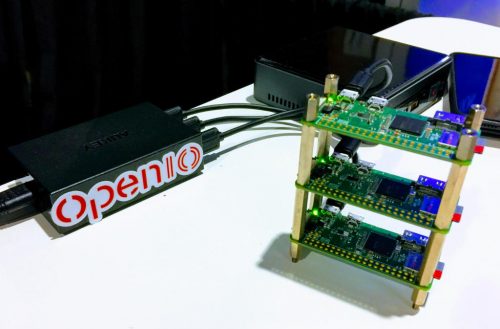
There was another appealing example at the ARM booth, where the Berkeley Labs’ singularity container platform was demonstrated running very effectively on a small cluster built with Raspberry Pi 3s.
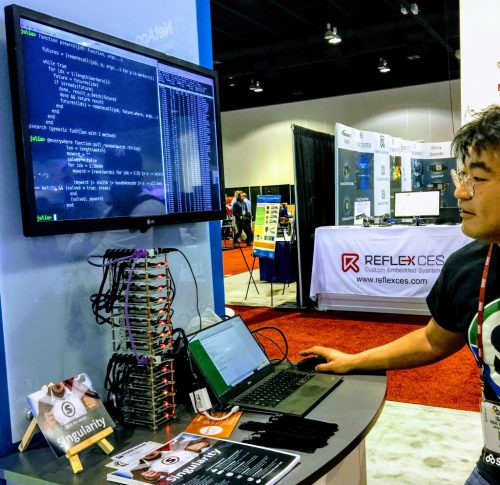
My show favourite was from the Edinburgh Parallel Computing Center (EPCC): Nick Brown used a cluster of Pi 3s to explain supercomputers to kids with an engaging interactive application. The idea was that visitors to the stand design an aircraft wing, simulate it across the cluster, and work out whether an aircraft that uses the new wing could fly from Edinburgh to New York on a full tank of fuel. Mine made it, fortunately!
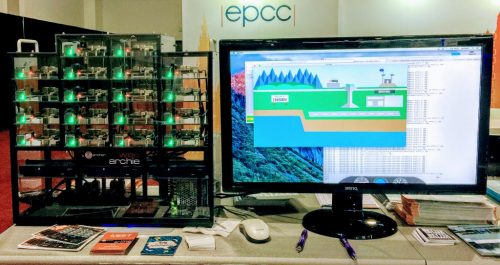
Next-generation Raspberry Pi clusters
We’ve been building small-scale industrial-strength Raspberry Pi clusters for a while now with BitScope Blade.
When Los Alamos National Laboratory approached us via HPC provider SICORP with a request to build a cluster comprising many thousands of nodes, we considered all the options very carefully. It needed to be dense, reliable, low-power, and easy to configure and to build. It did not need to “do science”, but it did need to work in almost every other way as a full-scale HPC cluster would.
Some people argue Compute Module 3 is the ideal cluster building block. It’s very small and just as powerful as Raspberry Pi 3, so one could, in theory, pack a lot of them into a very small space. However, there are very good reasons no one has ever successfully done this. For a start, you need to build your own network fabric and I/O, and cooling the CM3s, especially when densely packed in a cluster, is tricky given their tiny size. There’s very little room for heatsinks, and the tiny PCBs dissipate very little excess heat.
Instead, we saw the potential for Raspberry Pi 3 itself to be used to build “industrial-strength clusters” with BitScope Blade. It works best when the Pis are properly mounted, powered reliably, and cooled effectively. It’s important to avoid using micro SD cards and to connect the nodes using wired networks. It has the added benefit of coming with lots of “free” USB I/O, and the Pi 3 PCB, when mounted with the correct air-flow, is a remarkably good heatsink.
When Gordon announced netboot support, we became convinced the Raspberry Pi 3 was the ideal candidate when used with standard switches. We’d been making smaller clusters for a while, but netboot made larger ones practical. Assembling them all into compact units that fit into existing racks with multiple 10 Gb uplinks is the solution that meets LANL’s needs. This is a 60-node cluster pack with a pair of managed switches by Ubiquiti in testing in the BitScope Lab:
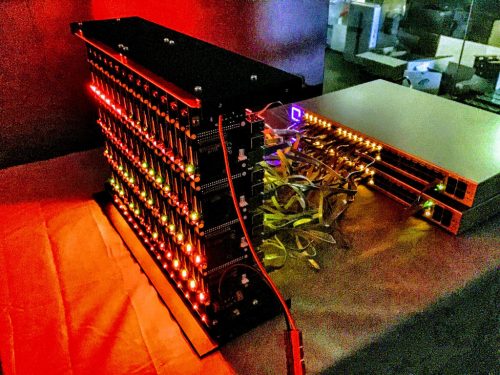
Two of these packs, built with Blade Quattro, and one smaller one comprising 30 nodes, built with Blade Duo, are the components of the Cluster Module we exhibited at the show. Five of these modules are going into Los Alamos National Laboratory for their pilot as I write this.
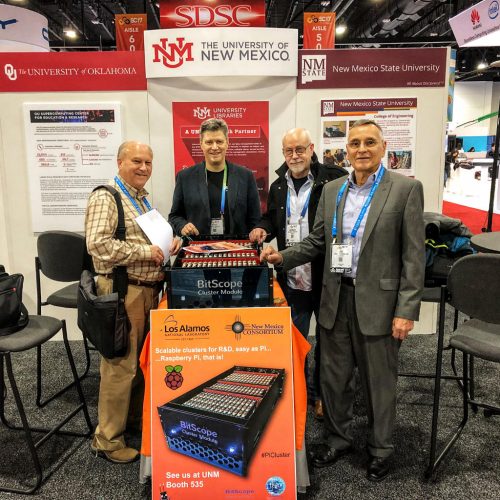
It’s not only research clusters like this for which Raspberry Pi is well suited. You can build very reliable local cloud computing and data centre solutions for research, education, and even some industrial applications. You’re not going to get much heavy-duty science, big data analytics, AI, or serious number crunching done on one of these, but it is quite amazing to see just how useful Raspberry Pi clusters can be for other purposes, whether it’s software-defined networks, lightweight MaaS, SaaS, PaaS, or FaaS solutions, distributed storage, edge computing, industrial IoT, and of course, education in all things cluster and parallel computing. For one live example, check out Mythic Beasts’ educational compute cloud, built with Raspberry Pi 3.
For more information about Raspberry Pi clusters, drop by BitScope Clusters.
I’ll read and respond to your thoughts in the comments below this post too.
Editor’s note:
Here is a photo of Bruce wearing a jetpack. Cool, right?!

Website: LINK
Schreibe einen Kommentar
Du musst angemeldet sein, um einen Kommentar abzugeben.